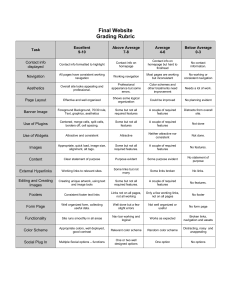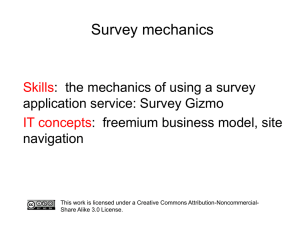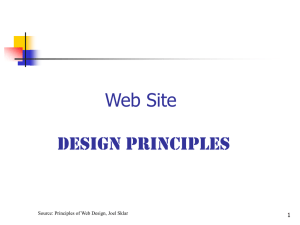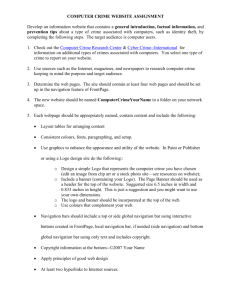Modeling the User Interface of Web Applications with UML
advertisement
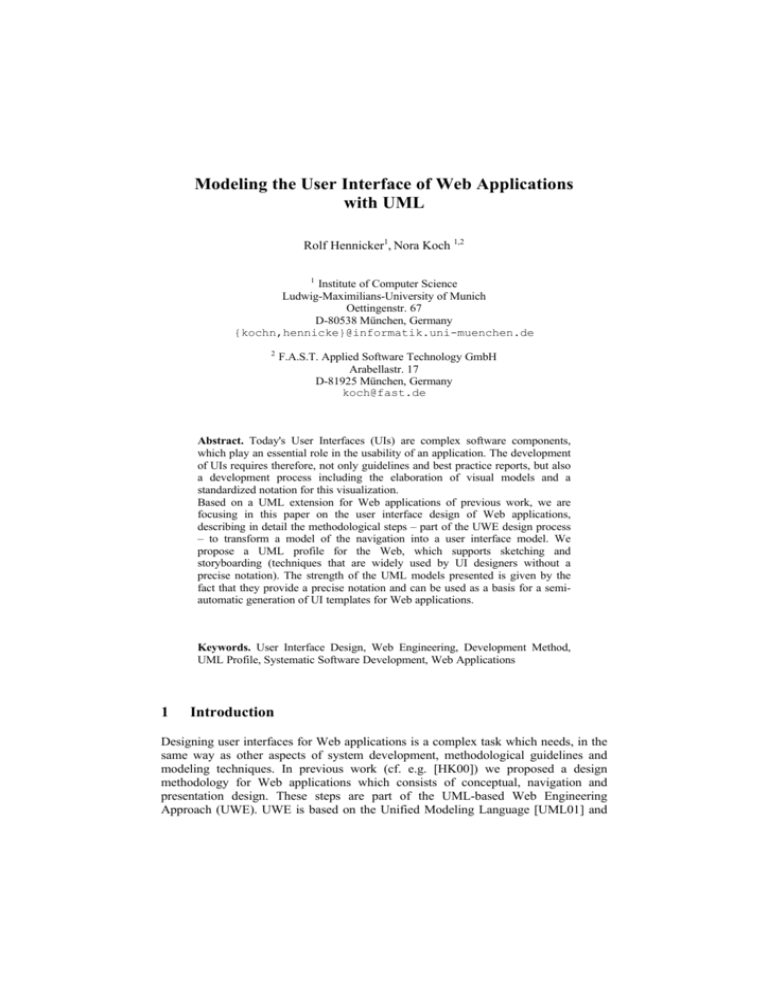
Modeling the User Interface of Web Applications
with UML
Rolf Hennicker1, Nora Koch 1,2
1
Institute of Computer Science
Ludwig-Maximilians-University of Munich
Oettingenstr. 67
D-80538 München, Germany
{kochn,hennicke}@informatik.uni-muenchen.de
2
F.A.S.T. Applied Software Technology GmbH
Arabellastr. 17
D-81925 München, Germany
koch@fast.de
Abstract. Today's User Interfaces (UIs) are complex software components,
which play an essential role in the usability of an application. The development
of UIs requires therefore, not only guidelines and best practice reports, but also
a development process including the elaboration of visual models and a
standardized notation for this visualization.
Based on a UML extension for Web applications of previous work, we are
focusing in this paper on the user interface design of Web applications,
describing in detail the methodological steps – part of the UWE design process
– to transform a model of the navigation into a user interface model. We
propose a UML profile for the Web, which supports sketching and
storyboarding (techniques that are widely used by UI designers without a
precise notation). The strength of the UML models presented is given by the
fact that they provide a precise notation and can be used as a basis for a semiautomatic generation of UI templates for Web applications.
Keywords. User Interface Design, Web Engineering, Development Method,
UML Profile, Systematic Software Development, Web Applications
1
Introduction
Designing user interfaces for Web applications is a complex task which needs, in the
same way as other aspects of system development, methodological guidelines and
modeling techniques. In previous work (cf. e.g. [HK00]) we proposed a design
methodology for Web applications which consists of conceptual, navigation and
presentation design. These steps are part of the UML-based Web Engineering
Approach (UWE). UWE is based on the Unified Modeling Language [UML01] and
on the Unified Process [JBR99]. The UML is extended to model Web applications
and the Unified Process is tailored for the development of these applications (cf.
[Ko00]).
The objective of the conceptual design is to build a conceptual model of the
application domain taking into account the functional requirements captured with use
cases. Traditional object-oriented techniques are used to construct the conceptual
model, such as finding classes and associations and defining inheritance structures.
The conceptual model is represented by an ordinary UML class diagram.
Based on the conceptual model the navigation design proposes a set of guidelines to
construct a navigation model which represents the navigation space and the access
elements that can be used for navigation (see Figure 1). We briefly summarize a set of
stereotyped modeling elements for navigation design, like indexes, guided tours,
queries and menus.
The presentation modeling aims at the design of abstract user interfaces and the
design of the user interaction with the Web application. It consists of two steps:
storyboarding user interfaces and building the presentation model which provides the
source for an implementation. In contrast to [HK00] we focus in this work on the
precise specification of the steps needed for a systematic design of the presentation.
For this purpose stereotyped modeling elements which are suited for storyboarding
and for modeling the concrete design of the presentation are included in our Web
Profile. Our goal was also to show how these stereotypes can be used together with
the WAE stereotypes of Conallen [Cj99] such that both approaches can benefit from
each other.
The first step in the presentation design defines user interface views which sketch the
content and the look and feel of the nodes. These user interface views can then be
combined to storyboarding scenarios that are an excellent basis for developing a
presentation model and constructing a pure HTML prototype. Sketching and
storyboarding are common techniques of user interface designers, but usually they
don’t have a unique and precise notation [Pj94,Sb98]. Our approach provides
methodological guidelines and modeling elements for storyboarding.
The next step of our method goes towards an implementation (Figure 1). Based on the
storyboard model the designer can decide whether he wants to choose a multiplewindow technique and/or whether he wants to use frames and/or dynamic page
generation. The objective of the presentation model is to show where the user
interface views of the storyboard model are presented to the user, i.e. in which frame
or window they are displayed. This also shows which contents are replaced when the
user interacts with the system. In addition to the client pages, constructed in
accordance with the user interface views, server pages in the sense of Conallen are
identified when they are required for the dynamic generation of client pages.
Conceptual
Model
«trace»
Navigation
Model
«trace»
Fig. 1: Models of the UWE design process
Presentation
Model
Related to our work are the UML extensions for interaction design provided by UMLi
and Wisdom. The UMLi approach [PP00] defines different graphical representations
for domain elements and interactive elements. It introduces notations for containers,
inputters, displayers, editors and action invokers. These elements are used for the
design of the abstract presentation without modeling the relationship between them.
The Wisdom approach [JFC00] supports task design.
This paper is structured as follows: Section 2 summarizes the design steps of the
UWE approach presented in previous work, i.e. the design of the conceptual model
and the navigation model. Section 3 gives guidelines to build sketches (abstract user
interfaces) with UML and how to use them to build storyboard scenarios. In Section
4, the presentation model is constructed showing where pages of a Web application
are presented to the user and how the user interacts through this interface with the
application. Finally, Section 5 presents some concluding remarks and an overview of
future work.
2
Starting with the Navigation Model
Our method supports the design of Web applications building conceptual, navigation
and presentation models. Conceptual modeling of Web applications does not differ
from conceptual modeling of other applications.
Navigation design is a critical step in the design of Web applications. Even simple
applications with a non-deep hierarchical structure will become complex very soon by
the addition of new links. Additional links improve navigability on the one hand but
imply, on the other hand, higher risk to loose orientation. Building a navigation model
is helpful not only for the documentation of the application structure, it also allows for
a more structured increase of navigability.
*
NavigationalClass
Menu
* MenuItem
{xor}
{xor}
Index
Access Element
Query
?
GuidedTour
Fig. 2: Metamodel of the Navigation Modeling Elements
2.1 Modeling Elements
For the construction of the navigation model a set of stereotypes are defined to
support a more intuitive modeling of the Web application. The stereotyped classes are
the «navigation class» and a set of access elements, such as «index», «guided tour»,
«query» and «menu», which are introduced and semantically explained in
[BKM99,HK00]. The directed associations expresses «direct navigability». Figure 2
defines the well-formedness rules of the navigation modeling elements in terms of a
metamodel. The class names occurring in this metamodel (with exception of the
abstract class access element) will be used as stereotypes when concrete navigation
models are constructed.
For instance, a particular index class can be defined as depicted in Figure 3 (left). For
this we will often use the icon notation shown in Figure 3 (right).
«index»
MyIndex
MyIndex
Fig. 3: Access Element Index
In particular, instead of the notation for menus in Figure 4 (left) we will use as a
shorthand notation the icon shown in Figure 4 (right) (and similarly for menus with
more than two menu items).
«menu»
MyMenu
Item1
Item2
item1
item2
MyMenu
Fig. 4: Access Element Menu
2.2 Example
As an example to illustrate the design process we use the Web Site of a service
company. This Web site offers information about the company itself, the departments,
employees and projects and their relationships. We restrict ourselves in the example
to these concepts, although many other aspects could be included (such as information
about products, documents, events, press releases and job offers). Figure 5 shows a
navigation structure model for this Web Site.
Company
1
head
employees
projects
departments
CompanyMenu
1
1
1
ByDepartment
Name
ByEmployee
Name
ByProyect
Name
1..*
Department
1
employees
projects
searchEmployees
1
?
1
1
ByEmployeeName
ByDepartment
1..*
1
1..*
searchBy
{xor} EmployeeName
ByDepartment
DepartmentMenu
1
ByProjectName
ByDepartment
0..1
Employee
1..*
1
1
projects
EmployeeMenu
1..*
1..*
Project
ByProjectNameByEmployee
Fig. 5: Navigation Model
2.3 The Method
Our methodology for the design – part of the UWE approach – presented in [HK00]
identifies a set of steps and guidelines for the construction of the navigation model.
The main steps are summarized as follows:
1. Classes of the conceptual model that are relevant for the navigation are included
as navigation classes in the navigation model (i.e. those classes that are not a
visiting target in the use case model are excluded).
2. Required information on the omitted classes can still be kept as attributes of
other classes in the navigation model. All other attributes of navigation classes
map directly to attributes of the corresponding conceptual classes.
3. Often additional directed associations are added for modeling direct navigability
(thus avoiding navigation paths of length greater than one). Scenarios described
by the use case model give the input for the choice of direct navigation.
4. Access elements (indexes, guided tours, queries) are chosen to realize the
navigation. In particular, role names at the directed ends of associations are
becoming menu items of menus attached to navigation classes.
3
Storyboarding User Interfaces
The objective of the user interface modeling is to provide a notation and a guidance
for the construction of a user interface visual model that shows the content and the
structure of the single nodes (i.e. how each node is presented to a user). First, the Web
designer proposes a sketch of each main user interface view. These are rough
drawings of a couple of relevant elements of each navigation node. This sketching
technique is frequently used by Web designers, but without having a precise notation
for it as described by Sano [Sd96].
We propose to use an appropriate extension of UML for this purpose. It is mainly an
abstract user interface design as it models only the structural organization of the
presentation, given by interface objects, such as texts, images, forms and menus, and
not the layout characteristics, in terms of fonts, colors, special formats, etc. Such
decisions are taken typically during the development of a user interface prototype or
in the implementation phase. The abstract user interface model may, however,
provide some hints, for example, on the position and the size of the interface objects
relative to each other.
In order to construct an abstract user interface model, one has to decide, on the one
hand, which user interface objects will be used for the presentation of the instances of
navigation classes and, on the other hand, which ones will be used for the presentation
of the access elements.
The abstract user interface design may be considered as an optional step as the design
decisions related to the user interface can also be taken during the realization of the
user interface. However, the production of sketches of this kind is often helpful in
early discussions with the customer.
After having designed the different user interface views storyboarding scenarios can
be developed which show sequences of user interface views in the order in which a
user can navigate from one view to another [Pj94]. This aids in visualizing the
organization of the Web application structure in a more intuitive manner than the
navigation model does. Both, the sketches of user interface views as well as the
storyboarding scenarios are a useful means for the communication between a
customer and a Web designer. In particular, they can be validated w.r.t. the use cases
identified during an analysis phase.
3.1
Modeling elements
For the construction of the abstract user interface we propose the modeling elements
shown in Figure 6. As for the navigation elements in Section 2, each class in Figure 6
defines a stereotype which will be used in concrete user interface models. The
associations and the inheritance relation show again the well-formedness rules; the
notation of the interface elements in form of icons stem from Baumeister, Koch and
Mandel [BKM99].
User Interface View. A user interface view specifies that each instance of this class
is a container of all the abstract user interface elements which are presented
simultaneously (i.e. at one moment in time in one window) to the user. For user
interface view classes we use the stereotype «UI view» and its corresponding icon
depicted in Figure 6.
1
1
UI View
1..*
*
PresentationClass
1..*
UI Element
Form
Collection
1..*
Text
{xor}
..
1..*
Image
...
..
AnchoredCollection
1..*
Anchor
Fig. 6: Metamodel of the Abstract User Interface Elements
Presentation Class. A presentation class is a structural unit which allows to partition
a user interface view into groups of user interface elements. For presentation classes
we use the stereotype «presentation class» and its corresponding icon depicted in
Figure 6.
User Interface Element. A user interface element is an abstract class which has
several specializations describing particular interface elements (Figure 6)1.
For instance, the stereotyped classes «text», «image», «video», «audio», «anchor»,
and «form», are subclasses of user interface element for modeling texts, images etc..
The classes «collection», and «anchored collection» are also subclasses of user
interface element which provide a convenient representation of frequently used
composites. Anchor and form are the basic interactive elements. An anchor is always
associated with a link for navigation. Through a form a user interacts with the Web
application supplying information and triggering a submission event.
3.2
Example
Figure 7 show a UI view that is part of the abstract user interface model of the service
company. It is the composite of the presentation of the company’s content (showing a
picture of the company etc.) and the company’s selection menu (which in turn is
composed by four anchors.)
«UI view»
CompanyView
«presentation class»
CompanyMenu
Head
Employees
Projects
Departments
«presentation class»
Company
«image»
Picture
«text»
Name
«text»
Email
«anchored collection»
Customers
..
.
Fig. 7: User Interface View for a Company
Figure 8 shows a storyboarding scenario which describes the navigation to find the
information about the head of the company and to find one department of the
company out of a list of departments.
1
We neither discuss here particular details of the user interface elements nor their
mapping to concrete GUI widgets.
3.3
The Method
To model an abstract user interface we assume given a navigation model of the
application. Each abstract user interface model is represented as a composition of
classes. The following rules can be used as guidelines for the construction of the
abstract user interface model:
1. Construct a presentation class for each navigation class occurring in the
navigation structure model. The presentation class defines a template suited to
present the instances of the class by taking into account the given attributes.
Stereotyped interface elements, such as «text», «image», «audio», «video» are
used for attributes of primitives types and «collections» are used for lists, etc.
Figure 7 shows the presentation class for a company.
2. Construct a presentation class for each menu and index occurring in the
navigation structure model. The presentation of a menu or an index class
consists usually of a list of anchors. Use stereotypes «anchor» or «anchored
collection» for this purpose. An example for the presentation of a menu is the
CompanyMenu in Figure 7.
3. Construct a presentation class for each query and guided tour. For queries use a
«form» stereotype and for guided tours use a menu with items “next” and
“previous” (which make it possible to navigate to the next and to the previous
object within a guided tour).
«UI view»
CompanyView
«presentation class»
CompanyMenu
1
«UI view»
HeadView
Head
«presentation class»
Employees
«presentation class»
HeadMenu
Company
Projects
Departments
Home
Head
«presentation class»
Employee
1
Employees
Projects
«UI view»
DepartmentIndex
Departments
«presentation class»
DepartmentMenu
1
Home
Head
Employees
Projects
«presentation class»
..
«anchored
collection»
Department
Index
*
«UI view»
DepartmentView
Departments
«presentation class»
DepartmentMenu
Home
Head
Employees
Projects
Departments
Fig. 8: Storyboard Scenario for Head and Department
«presentation class»
Department
4. Determine which presentation elements should be presented together to the user
(in one window). The corresponding presentation classes must be composed in a
user interface view (stereotyped by «UI view»). Since the user needs always a
combination of conceptual data and navigation facilities, typically a user
interface view consists of the presentation class constructed for a navigation
class and of a presentation class constructed for a corresponding menu class (see
CompanyView in Figure 7).
5. Construct storyboarding scenarios represented by sequences of user interface
views. For this purpose introduce links that connect an anchor (within a UI
view) with another UI view thus showing the possible flows of presentations
that can be caused by user interactions. An example for a storyboard model is
the scenario for Head and Department shown in Figure 8.
4
Building the Presentation Model
The focus of this step is to decide where the navigation objects and access elements
will be presented to the user, i.e. in which frame or window the content is displayed
and which content will be replaced when a link is activated. First of all, the designer
has to specify whether a single or multiple-window technique is used, whether frames
are used and, if so, into how many frames framesets are divided. In the case of one
window without frames the result is obvious from the storyboard model and no
further graphical representation is needed. Each click produces just a complete
replace of the window content by a new content. The dynamics of the presentation is
optionally shown by a presentation flow.
4.1
Modeling Elements
A presentation model of a Web application is built with stereotyped classes
«window», «frameset», «frame», «client page», «server page», «client script» and
«server script». The user interface elements defined in Section 3, are used as well, but
now in a more elaborated context. We also use the following stereotyped associations:
«builds», «redirect», «submit», «link» and «displays». Many of the stereotyped
modeling elements stem from the WAE of Conallen and can be smoothly integrated
in our approach.
To indicate the location of a presentation we use windows and frames (which both
can be targets used in an anchor). Server pages, client pages and framesets specify
contents (generally called Web pages) which are displayed in a target. Those
modeling elements which are new or differ semantically from the definitions in
[Cj99] are listed in the following.
Target. Target is an abstract class used to generalize the concept of window and
frame, both being compartments of the screen in which Web pages are displayed.
Window. A window is the area of the user interface where presentation objects are
displayed. A window can be moved, maximized/minimized, resized, reduced to an
icon and/or closed. For performing these actions a window contains special buttons.
In addition, windows include two scrollbars: a horizontal and a vertical scrollbar that
allow for visualization of the whole content of the window. Any window is an
instance of a class stereotyped by «window» with a corresponding icon (see Figure 9).
Frameset. A frameset is a modeling element used to define multiple visualization
areas within a window. It is divided into lower level location elements – so called
frames – and may also contain an arbitrary number of nested framesets. A frameset is
an instance of a frameset class stereotyped by «frameset» with a corresponding icon
(see Figure 9).
Frame. A frame is always part of a frameset, it defines an area of the corresponding
frameset where content is displayed. A frame is an instance of a frame class
stereotyped by «frame» with a corresponding icon (see Figure 9).
Displays. The «displays» association specifies that in the target a Web page is
displayed (frame or window). It is a directed association.
Links. The directed association «links» points from an anchor to a Web page. Its
semantic is an individual connection among two objects.
Targets. A directed association «targets» points from an anchor to a target. It specifies
that this target is used to display the object linked by the anchor.
Figure 9 shows a metamodel for the above modeling elements defining the wellformedness rules for their use in concrete presentation models. As already mentioned,
all class names occurring in the metamodel will be used as stereotypes in concrete
redirects
reference
Web Page
links
source
displays
Server Page
builds
Client Page
*
Frameset
*
Server Script
*
*
User Interface
Element
Client Script
1..*
1..*
Frame
Target
0..1
Window
submits
targets
Form
Text
...
Anchor
Fig. 9: Modeling Elements for the Presentation Model (Metamodel)
models. A presentation model must be built conform to the composition structure of
classes shown in Figure 9. Consequently, these stereotypes are restrictive stereotypes
in the sense of [BGJ99].
4.2 Example
Figure 10 shows (part of) the presentation model for the Web site of the service
company. Figure 11 shows (using a UML sequence diagram) a presentation flow
representing a scenario for a sequence of possible navigation activities that can be
performed by a user of the application.
«window»
TopWindow
«displays »
«frameset»
CompanyFrameset
«targets»
«frame»
«frame»
Left
Right
«displays»
«displays »
« displays»
«client page»
«client page»
Head
«frameset»
Company
CompanyMenu
MainFrameset
«links»
Employees
«displays »
«frame»
«frame»
Main
Left
Main
Right
Projects
«client page»
Employee
{xor}
«displays»
Departments
«displays »
«client page»
MainMenu
«links»
Home
«targets »
Head
Employees
Projects
Departments
«links»
«server page»
DeptartmentIndex
«builds »
«client page»
DepartmentIndex
Fig. 10: View of the Presentation Model of the Company Web Site
4.3
The Method
The presentation model requires that the designer takes some decisions, such as
number of windows to be used and number of frames each frameset is divided into.
Hence the construction of the presentation structure cannot be fully automated, but
there are certain guidelines that the designer can follow:
1. Select between a single or multiple-window technique. In case of a multiplewindow technique plan how many windows will be used.
2. Decide whether frames will be used for the realization. If this is the case specify
how many frames each frameset has. Typically the partitions of the user
interface views of the abstract user interface model will be realized by frames.
3. Transform the presentation classes of the abstract user interface model into Web
pages of the presentation model. In most cases this is straightforward since only
the anchors and forms have now to be directed to appropriate Web pages or
server scripts by using associations stereotyped by «link» or «submits»,
respectively. If a client page should be dynamically generated a corresponding
server page and an association stereotyped by «builds» must be introduced.
4. Decide in which frame (of a frameset) or in which window a Web page is to be
presented to the user. This will be modeled by the target associated to an anchor.
If many windows and/or frames are used, it is advisable to construct partial views of
the presentation model to avoid an overloaded notation.
The construction of the presentation flow can follow the guidelines listed below. Note
that in this representation it is not relevant whether the pages are static HTML pages
or they are generated dynamically.
window1 :
Window
: User
: Left
: Right
display (CompanyFrameset
)
display(CompanyMenu)
display(Company)
select(Head)
display(MainFrameset)
display(MainMenu)
display(Employee)
select(Department Índex)
display(DepartmentIndex)
Fig. 11: Presentation Flow for a Scenario of the Company Web Site
1. Set the scenario for the interaction model, i.e. define which navigation path of
the navigation structure diagram will be modelled.
2. Represent the user, the windows and/or frame objects in the horizontal
dimension.
3. Specify a display message for each presentation object that should be presented
to the user (in a window or frame). The parameter of the display message is the
corresponding presentation object (described in previous sections).
4. Include a select message for each user action which selects an anchor or a
button. The anchor or button names are the parameters of the message.
5. Specify a fill and a submit message for each user action which consists of
supplying data in a query form. This form is the parameter of the message.
6. Include a message for each open and each close of a window.
7. Use “balking” to specify the period of time that a window or frame is active.
5
Conclusions and Future Work
In this paper we propose the use of a UML Web Profile to model the user interface of
Web applications. This approach focuses on the presentational aspects already
outlined in [HK00], but there the focus was on the systematic modeling of the
navigation. We present stereotypes that are added to our UML extension for Web
applications and show how these stereotypes can be integrated in the design with the
WAE stereotypes of Conallen.
Using the navigation model as a starting point we construct the presentation model in
two steps. The first one aims to sketch the content of the nodes showing the look and
feel of user interface views of the Web application. These views are used to build
storyboarding scenarios that are an excellent basis for the development of the
realization of a prototype. The second step goes towards an implementation. At this
point the designer has to take decisions about multiple-window technique, the use of
frames and dynamic page generation. The objective of the presentation model is to
show where the contents, after being realized in client pages, are presented to the user,
i.e. in which target they are displayed and which other content of the frame or window
is replaced. Additionally, server pages are identified when they are required for the
dynamic construction of client pages. The methodical design of the presentation of a
Web application is part of the UWE approach. The strength of our methodology is
given by the fact that some steps can be performed in an automatic way thus
providing the basis for a generation mechanism in the Web design.
In future work we plan to elaborate a more formal and detailed specification of the
modeling elements in the metamodel supplemented with well-formedness constraints
written in OCL.
An important next step is to extend existing Case Tools, such as ArgoUML [Au01],
with the set of stereotypes of our Web Profile to allow for visualization of the
stereotypes through the corresponding icons. In addition, a Case Tool that supports
the development of Web applications based on our method is planned. It will consist
of different editors for conceptual, navigation and presentation design. The objective
is to systematize as much as possible the process according to the steps specified in
our methodology. It will prove consistency by using the given well-formedness rules
for the modeling elements.
References
[Au01]
[BKM99]
ArgoUML: The Cognitive CASE Tool. http://argouml.tigris.org (2001)
Baumeister, H., Koch, N., Mandel L.: Towards a UML extension for hypermedia
design. In Proceedings «UML»’99, France, R., Rumpe, B. (Eds), LNCS, Vol.
1723. Springer-Verlag (1999) 614-629.
[BGJ99]
Berner S., Glinz M., Joos S.: A classification of stereotypes for object-oriented
modeling languages. In Proceedings «UML»’99, France, R., Rumpe, B. (Eds),
LNCS, Vol. 1723. Springer-Verlag (1999) 249-264.
[Cj99]
Conallen J.: Building Web Applications with UML. Addison-Wesley (1999).
[HK00]
Hennicker R., Koch N.: A UML-based Methodology for Hypermedia Design. In
Proceedings «UML» 2000, Evans, A., Kent, S. (Eds), LNCS, Vol. 1939. SpringerVerlag (2000) 410-424.
[JBR99]
Jacobson I., Booch G., Rumbaugh J.: The Unified Software Development Process.
Addison Wesley (1999).
[JFC00] Jardim Nunes N., Falcao e Cunha J. (2000). Towards a UML Profile for Interaction
Design: The Wisdom Approach. In Proceedings «UML» 2000, Evans, A., Kent, S.
(Eds), LNCS, Vol. 1939. Springer-Verlag (2000) 101-116.
[Ko00]
Koch N.: Hypermedia Systems Development based on the Unified Process.
Technical Report 0003, Ludwig-Maximilians-University Munich (2000).
[KKH01] Koch N, Kraus A., Hennicker R.: The Authoring Process of the UML-based Web
Engineering Approach (Case study). Proceedings of the 1st International Workshop
on Web-oriented Software Technology, 2001, to appear.
[PP00]
Pinheiro da Silva P., Paton N.: UMLi: The Unified Modeling Language for
Interactive Applications. In Proceedings «UML» 2000, Evans, A., Kent, S. (Eds),
LNCS, Vol. 1939. Springer-Verlag (2000) 117-132.
[Pj94]
Preece J., Rogers H., Benyon D., Holland S., Carey T.: Human-Computer
Interaction. Addison Wesley (1994).
[Sd96]
Sano D.: Lare-Scale Web Sites – A Visual Design Methodology. Wiley Computer
Publishing (1996).
[Sb98]
Shneiderman B. Designing the User Interface: Strategies for effective HumanComputer Interaction. Addison Wesley (1998).
[UML01] UML: The Unified Modeling Language. http://www.omg.org/uml/ (2001)


